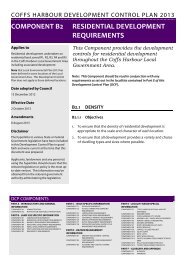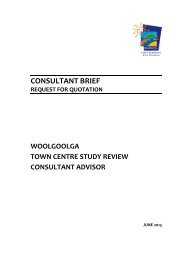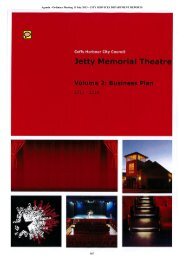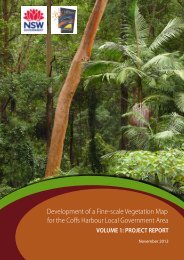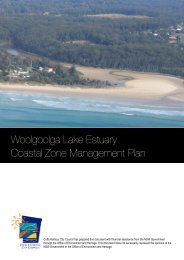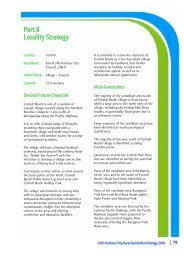Industrial Lands Strategy - Section 9 - Coffs Harbour City Council ...
Industrial Lands Strategy - Section 9 - Coffs Harbour City Council ...
Industrial Lands Strategy - Section 9 - Coffs Harbour City Council ...
You also want an ePaper? Increase the reach of your titles
YUMPU automatically turns print PDFs into web optimized ePapers that Google loves.
9.2 <strong>Industrial</strong> <strong>Lands</strong> Planning ApproachPlanning for existing and future industrial land within the <strong>Coffs</strong> <strong>Harbour</strong> LGA is limited by a number offactors. This section of the <strong>Industrial</strong> <strong>Lands</strong> <strong>Strategy</strong> identifies these constraints and opportunities andprovides a framework to assist <strong>Council</strong> in planning for industrial lands within the LGA. The recommendedindustrial lands planning approach is outlined below.9.2.1 The Growth Areas Map of the Mid North Coast Regional <strong>Strategy</strong>The Mid North Coast Regional <strong>Strategy</strong> identifies growth areas in all of the Local Government Areas withinthe Mid North Coast region. These growth areas are contained in the Growth Areas Map and have beenprepared to reinforce the region’s settlement hierarchy and provide for a range of housing types andemployment lands to meet the needs of the region’s growing population. The Department of Planning hasadvised that local councils will only be able to identify land to be rezoned for urban purposes if the land:• is within the identified areas on the growth area maps;• is within the existing identified urban footprint within the growth area maps; or• complies with the Mid North Coast Regional <strong>Strategy</strong>’s sustainability criteria.Further discussions with the Department of Planning indicate that it is unlikely that the department willsupport the rezoning of land for development in the short to medium term for areas that fall outside thegrowth area maps. This <strong>Industrial</strong> <strong>Lands</strong> <strong>Strategy</strong> proposes to limit short to medium term release of landfor industrial land uses to areas identified in the Growth Areas Map. The <strong>Strategy</strong> does however identifyland which is outside of the growth area maps and the identified urban footprint for medium to longer termrezoning for industrial land use.9.2.2 Constraints within the LGAWhilst there are a number of opportunities for industrial development within <strong>Coffs</strong> <strong>Harbour</strong>, given itsregional centre focus, projected population increase, relatively high unemployment and desirability as aplace to live, there are also a number of constraints to development that need to be considered. <strong>Coffs</strong><strong>Harbour</strong> has a diverse landscape with many competing interests including biodiversity; agricultural lands;lifestyle pressures; urban expansion; ecologically sensitive areas (such as creeks, vegetated areas andwetlands); the Great Dividing Range and the Pacific Ocean. These competing interests have presented anumber of challenges in preparing this <strong>Industrial</strong> <strong>Lands</strong> <strong>Strategy</strong>. The recommendations contained in this<strong>Strategy</strong> seek to balance these competing needs in order to identify ecologically sustainable developmentoutcomes.9.2.3 Determining Levels of Required Supply of <strong>Industrial</strong> Land<strong>Industrial</strong> employment, floorspace and land area forecasting prepared by SGS Economics and Planningsuggest demand for an additional:• 135,398 sqm of industrial floorspace in the period 2006-2026, or• 39.9 ha of industrial land area in the period 2006-2026.If the forecast period is extended out to 2031, so that it is consistent with the Mid-North Coast Regional<strong>Strategy</strong>, the projected area of industrial land needed is increased to 50 ha. These figures representunderlying demand. The way that this is translated into observed demand or industrial land take-updepends on a range of other market factors (such as interest rates, construction costs, etc) and principallythe nature of land supply. At the simplest level, this means having sufficient land volumes to correspondwith the demand volume. However the <strong>Strategy</strong> also needs to ensure that there is sufficient supply ofindustrial land suitably positioned and configured to respond to the nature of demand. There is no setstandard or ratio for an appropriate level of industrial land supply.<strong>Coffs</strong> <strong>Harbour</strong> <strong>City</strong> <strong>Council</strong> Local Growth Management<strong>Strategy</strong> - <strong>Industrial</strong> <strong>Lands</strong> Component<strong>Section</strong> 9102



